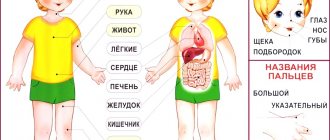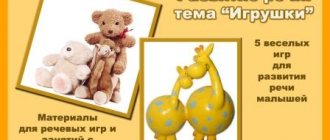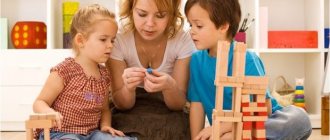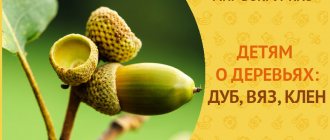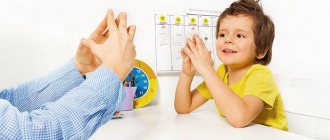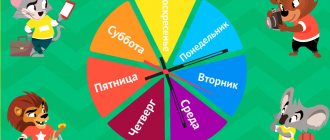The level of development of speech and cognitive abilities of preschoolers aged 4-5 years is already quite high: children actively communicate, have an extensive vocabulary that they can use in any situation, calmly describe a variety of objects, and obvious defects disappear from their speech. If this does not happen, then the likelihood of a diagnosis of speech development delay (speech development delay) increases several times. An examination by specialized specialists will help determine the cause of the delay and guide parents along the right path. At this age, the problem is not yet critical and can be eliminated with a competent combination of treatment (if necessary), speech development classes with a speech pathologist and classes with the participation of parents at home.
Norms of speech development at the age of 4-5 years
In order to timely identify problems with speech development, it is necessary to navigate what the baby should be able to do, and only after that “sound the alarm” by turning to speech therapists and speech pathologists. According to the norms of speech development for children from 4 to 5 years old, at this age a child should be able to:
- speak in such a way that everyone around you understands him, not just those closest to you;
- calmly operate with your vocabulary (minimum 3000 words); build logical sentences from 6-8 phrases;
- understand the difference between people, animals and inanimate objects, know their characteristics and distinctive features (animals cannot speak, a dog has four legs, a cat meows, etc.);
- be able to find an object, focusing only on its description (for example, a ball - round, blue, bouncy) and create descriptions of objects yourself;
- understand the meaning of prepositions and insert them correctly into sentences;
- have an understanding of different professions, who does what (teacher - teaches children, pastry chef - bakes cakes, etc.);
- be able to maintain a conversation on topics that he understands, ask relevant questions and answer questions put to him;
- retell heard stories, fairy tales, and entertaining stories without difficulty;
- know by heart simple rhymes, nursery rhymes, tongue twisters for children; state your first and last name without prompting, know your age and residential address;
- be able to answer questions about your pastime (where you were, what you ate for breakfast, who you met on the way to kindergarten, etc.).
Diagnostics of ZZR
Diagnosis of mental disorders includes checking the following indicators: pronunciation of sounds;
- sound-syllable structure of the word;
- phonetic sensitivity;
- possibilities of phonemic analysis of synthesis;
- the state of vocabulary and grammatical structure of impressive, expressive and coherent speech.
Based on the test data, the speech therapist draws up a diagnostic card describing the features of the child’s speech development, on the basis of which a conclusion is made and recommendations are made regarding speech development classes.
Card index of didactic games on speech development in the middle group
Olya Sorokina
Card index of didactic games on speech development in the middle group
Card index of didactic games on speech development in the middle group
1. “Who talks like that?”
Goal: expanding vocabulary, developing reaction speed .
Progress: the teacher throws the ball to the children one by one, naming the animals. Children, returning the ball, must answer how this or that animal gives a voice: A cow moos A tiger growls A snake hisses A mosquito squeaks A dog barks A wolf howls A duck quacks A pig grunts Option 2. The speech therapist throws the ball and asks: “Who is growling?”
,
“Who’s mooing?”
,
"Who's barking?"
,
"Who's crowing?"
etc.
2. "Who lives where?"
Goal: to consolidate children’s knowledge about the homes of animals and insects. Consolidating the use of the grammatical form of the prepositional case with the preposition “in”
.
Progress: Throwing the ball to each child in turn, the teacher asks a question, and the child, returning the ball, answers. Option 1. teacher: -Children: Who lives in a hollow? -Squirrel. Who lives in a birdhouse? - Starlings. Who lives in the nest? - Birds. Who lives in the booth? - The dog. Who lives in the hive? - Bees. Who lives in the hole? - Fox. Who lives in the lair? -Wolf. Who lives in the den? - A bear. Option 2. teacher: - Children: Where does the bear live? - In a den. Where does the wolf live? - In the lair. Option 3. Work on the correct construction of the sentence. Children are asked to give a complete answer: “The bear lives in a den”
.
3. "Give me a word"
Goal: development of thinking , speed of reaction.
Move: the teacher, throwing the ball to each child in turn, asks: “The crow is croaking, and what about the magpie?” The child, returning the ball, must answer: - The magpie is chirping. Examples of questions: - The owl flies, but what about the rabbit? - The cow eats hay, and the fox? - The mole digs holes, and the magpie? - The rooster crows, and the chicken? - The frog croaks, and the horse? - The cow has a calf, and the sheep? – The bear cub has a mother bear, and the baby squirrel?
4. “Who moves how?”
Goal: enrichment of children’s verbal vocabulary, development of thinking , attention, imagination, dexterity.
Move: the teacher, throwing the ball to each child, names an animal, and the child, returning the ball, pronounces a verb that can be attributed to the named animal. Teacher: - Children: Dog - stands, sits, lies, walks, sleeps, barks, serves (cat, mouse)
5. "Hot Cold"
Goal: to consolidate in the child’s mind and vocabulary the opposite characteristics of objects or antonym words.
Move: the teacher, throwing the ball to the child, pronounces one adjective, and the child, returning the ball, names another - with the opposite meaning. Teacher: - Children: Hot-cold Good-bad Smart-stupid Cheerful-sad Sharp-dumb Smooth-rough
6. “What happens in nature?”
Goal: to consolidate the use of verbs in speech, agreement of words in a sentence.
Move: the teacher, throwing the ball to the child, asks a question, and the child, returning the ball, must answer the question asked. It is advisable to play the game according to themes. Example: Theme “Spring”
teacher: -Children: The sun - what is it doing? - It shines, it warms. Streams - what are they doing? -They are running and murmuring. Snow - what does it do? — It’s getting dark, melting. Birds - what are they doing? - They fly in, build nests, sing songs. Drops - what does it do? - It rings and drips. The bear - what does it do - wakes up, crawls out of the den.
7. “Who can perform these actions?”
Goal: activation of children's verbal dictionary, development of imagination , memory, dexterity. Progress: the teacher, throwing the ball to the child, names the verb, and the child, returning the ball, names the noun that matches the named verb. Teacher: - Children: Walking - person, animal, train, steamboat, rain... A stream runs, time, an animal, a person, a road... A bird, a butterfly, a dragonfly, a fly, a beetle, an airplane flies... A fish, a whale, a dolphin, a boat, a ship, a man floats...
8. “What is it made of?”
Goal: to consolidate the use of relative adjectives and methods of their formation in children’s speech.
Move: the teacher, throwing the ball to the child, says: “Boots made of leather”
, and the child, returning the ball, answers:
“Leather.”
Teacher: - Children: Fur mittens Copper basin Copper vase Crystal crystal Mittens wool
9. "Put it into pieces"
Goal: orientation in space.
Progress: the character Fyodor asks the guys to help her: put pots and pans on the bottom shelf, plates, spoons, knives and forks on a higher shelf, and saucers and jugs on the top shelf.
10. “Who was who?”
Goal: development of thinking , expansion of vocabulary, consolidation of case endings.
Move: the teacher, throwing the ball to one of the children, names an object or animal, and the child, returning the ball to the speech therapist, answers the question of who (what)
there was a previously named object: Chicken - egg Bread - flour Horse - foal Wardrobe - board Cow - calf Bicycle - iron Dud - acorn Shirt - fabric Fish - egg Boots - leather Apple tree - seed House - brick Frog - tadpole Strong - weak Butterfly - caterpillar Adult - child
11. “Which vegetable?”
Goal: development of tactile , visual and olfactory analyzers.
Procedure: the teacher cuts the vegetables, the children smell and taste them. The teacher gives an example: “The tomato is sweet, but the garlic is spicy.”
12. “What does it sound like?”
Goal: development of auditory attention and observation.
Progress: the teacher behind the screen plays various musical instruments (tambourine, bell, wooden spoons)
. Children must guess what it sounds like.
13. “What happens in the fall?”
Purpose: to teach the seasons, their sequence and main features.
Progress: on the table are mixed pictures depicting various seasonal phenomena (it is snowing, a flowering meadow, an autumn forest, people in raincoats and with umbrellas, etc.). The child chooses pictures that depict only autumn phenomena and names them.
14. “What’s missing?”
Goal: development of attention and observation.
Progress: the teacher lays out 4 vegetables on the table: “Children, look carefully at what is on the table. These are onions, cucumbers, tomatoes, peppers. Look carefully and remember. Now close your eyes.” Children close their eyes, and the teacher removes one vegetable. “What’s missing?”
Children remember and name the vegetable.
15. “Catch and throw – name the colors”
Goal: selection of nouns for the adjective denoting color. Consolidating the names of primary colors, developing imagination in children .
Move: the teacher, throwing the ball to the child, names an adjective denoting color, and the child, returning the ball, names a noun that matches this adjective. Teacher: - Children: Red - poppy, fire, flag Orange - orange, carrot, dawn Yellow - chicken , sun, turnip Green - cucumber, grass, forest Blue - sky, ice, forget-me-nots Blue - bell, sea, sky Violet - plum, lilac, dusk
16. "Whose head?"
Goal: expanding children's vocabulary through the use of possessive adjectives. Procedure: the teacher, throwing the ball to the child, says: “The crow has the head...”
, and the child, throwing the ball back, finishes:
“...crow.”
For example: A lynx has a lynx’s head. Fish - fishy Cat - feline In a magpie - magpie In a horse - equine In an eagle - eagle In a camel - camel
17. "The Fourth Wheel"
Goal: to consolidate children’s ability to identify common features in words and develop the ability to generalize.
Move: the teacher, throwing the ball to the child, names four words and asks to determine which word is superfluous. For example: blue, red, green, ripe. Zucchini, cucumber, pumpkin, lemon. Cloudy, stormy, gloomy, clear.
18. "One is many"
Goal: to consolidate various types of endings of nouns in children’s speech.
Progress: the teacher throws the ball to the children, calling singular nouns. Children throw the ball back, naming the nouns in the plural. Example: Table - tables chair - chairs Mountain - mountains leaf - leaves House - houses sock - socks Eye - eyes piece - pieces Day - days jump - jumping Sleep - dreams gosling - goslings Forehead – foreheads tiger cubs
19. "Pick up the signs"
Goal: activation of the verb dictionary.
Progress: the teacher asks the question “What can squirrels do?”
Children answer the question and find
a picture for the question asked . Sample answers: Squirrels can jump from branch to branch.
Squirrels know how to make warm nests. 20. "Animals and their young"
Goal: to consolidate the names of baby animals in children’s speech, consolidate word formation skills, develop dexterity , attention, and memory.
Move: throwing the ball to the child, the teacher names an animal, and the child, returning the ball, names the baby of this animal. The words are arranged into three groups according to the method of their formation. The third group requires memorizing the names of the cubs. Group 1 . The tiger has a tiger cub, the lion has a lion cub, the elephant has a cub, the deer has a fawn, the elk has a calf, the fox has a fox calf. Group 2 . A bear has a baby bear, a camel has a baby camel, a hare has a baby hare, a rabbit has a baby rabbit, a squirrel has a baby squirrel. Group 3 . A cow has a calf, a horse has a foal, a pig has a piglet, a sheep has a lamb, a hen has a chick, a dog has a puppy.
21. “What is round?”
Goal: expanding children's vocabulary through adjectives, developing imagination , memory, and dexterity.
Move: the teacher, throwing the ball to the children, asks a question; the child who caught the ball must answer it and return the ball. -What is round? (ball, globe, wheel, sun, moon, cherry, apple)
– what is long?
(road, river, rope, tape, cord, thread)
- what is tall?
(mountain, tree, rock, person, pillar, house, closet)
- what is prickly?
(hedgehog, rose, cactus, needles, Christmas tree, wire)
22. “Pick up a word”
Goal: development of word formation skills, selection of related words. For example, bee - bee, little bee, beekeeper, beekeeper, bees, etc.
23. "Generalizing concepts"
Goal: expansion of vocabulary through the use of generalizing words, development of attention and memory , ability to correlate generic and specific concepts.
Option 1. Move: the teacher names a generalizing concept and throws the ball to each child in turn. The child, returning the ball, must name the objects related to that general concept. Teacher: - Children: Vegetables - potatoes , cabbage, tomato, cucumber, radish
. Option 2. The teacher names specific concepts, and the children name generalizing words. Teacher: Children: Cucumber, tomato - Vegetables.
24. "Good bad"
Goal: introducing children to the contradictions of the world around them, developing coherent speech and imagination.
Progress: the teacher sets the topic of discussion. Children, passing the ball in a circle, tell what, in their opinion, is good or bad in weather phenomena. Teacher: Rain. Children: Rain is good: it washes away dust from houses and trees, it is good for the earth and the future harvest, but bad - it gets wet us, it can be cold.Teacher: City.Children: It’s good that I live in the city: you can go on the subway, by bus, there are a lot of good shops, the bad thing is that you won’t see a live cow or rooster, it’s stuffy, dusty.
25. "Near and Far"
Goal: development of auditory attention , hearing acuity.
Progress: the teacher behind the screen produces sound with a large or small toy. Children determine the size of the toy (large or small)
26. "Call me kindly"
Goal: strengthening the ability to form nouns using diminutive suffixes, developing dexterity and reaction speed.
Move: the teacher, throwing the ball to the child, calls the first word (for example, ball), and the child, returning the ball, calls the second word (ball)
.
Words can be grouped by similar endings. Table-table, key-key. Beanie hat, squirrel squirrel. Book-book, spoon-spoon. Head-head, picture-picture .
Soap-soap, mirror-mirror. Doll-doll, beet-beet. Braid-braid, water-water. Beetle-beetle, oak-oak. Cherry-cherry, tower-tower. Dress-dress, chair-chair. 27. "Fun account"
Goal: to consolidate the agreement of nouns with numerals in children’s speech.
Move: the teacher throws the ball to the child and pronounces a combination of a noun and the numeral “one”
, and the child, returning the ball, responds with the same noun, but in combination with the numeral
“five”
,
“six”
,
“seven”
,
“eight”
. Example: One table - five tables One elephant - five elephants One crane - five cranes One swan - five swans One nut - five nuts One cone - five cones One goose - five goslings One chicken - five chickens One hare - five hares One hat - five hats One can - five cans.
28. “Guess who called?”
Goal: distinguishing the most abbreviated sound complexes by timbre.
Move: the driver turns his back to the children and uses the sound complex “pee-pee”
determines who called him. The child the teacher points to calls the driver.
Didactic games
Didactic games for speech development for children 4-5 years old are varied, let’s look at the most popular ones.
- Find the mistake
This game allows you to correctly pronounce and remember words that have many words, and also actively develop auditory attention. For example, a child is shown a card of a baby elephant and told: he has a trunk (true), he runs fast (not true), he is heavy (true). In addition to the characteristics mentioned above, the child is asked to name a few more.
- That may or may not be the case
Thanks to this game, children learn to notice inconsistencies and actively develop their logical thinking. In individual sentences or short stories, it is necessary to identify what cannot be. For example: “Autumn has come and the first green leaves have begun to appear on the trees.”
- What season
Through poetry and descriptive stories, one can learn to identify the seasons very easily.
- Which, which, which
For a word that an adult asks for, it is necessary to choose the correct definition. For example: “The sun is yellow, hot, round”, “Snow is white, wet, cold”, “The hat is new, blue, warm.”
- Guess the plant
Independently describing objects and guessing what is described by an adult allows you to develop attention and memory, learn to correctly describe objects and guess them based on their characteristics.
- What happens
The child is asked to tell what could be, for example, blue - the sky, sea, mother's eyes, or tall - a fence, a house, a tree. Such activities help not only to develop attention, but also to develop the ability to classify objects according to different criteria: shape, color, etc.
- When does this happen
The child is presented with pictures that depict different actions (for example, it is snowing). It is necessary to determine when this happens (the correct answer is in winter).
Most didactic games are used by kindergarten teachers in accordance with the current Federal State Educational Standards, which are aimed at the active development of speech in preschool children. A complete list of all kinds of didactic games and various exercises (with detailed instructions) can be found in Programs for the development of speech and cognitive abilities for children 4-5 years old by different authors (Karpova S.I., Mamaeva V.V., Ushakova O.S.).
S.I. Karpova V.V. Mamaeva Development of speech and cognitive abilities of preschoolers 4-5 years old
Ushakova O.S. Speech development program for preschool children
Didactic games
for the development of speech in middle-aged children
- "Find the first sound"
Target
: learn to clearly identify the first sound in a word.
For this game you need a car and various toys, but among them there must be an elephant and a dog.
The adult invites the child to name all the toys and take for a ride in the car those animals whose names begin with the sound “s” (elephant, dog). If a child names a word that does not have the sound “s,” then the adult pronounces this word, highlighting each sound, for example, koooshshshkaaa.
An adult puts a goose in a car, but the car does not move.
“The car won’t move because the word goose has the sound “s” and not “s.”
Developed speech hearing allows children to distinguish between rising and falling voice volumes, slowing down and speeding up the rate of speech of adults and peers. Moreover, such exercises can be carried out in parallel with the selection of sounds in words and phrases.
- "Loud - whisper"
Target:
teach children to select similar-sounding phrases and pronounce them loudly or in a whisper.
The adult says that a wasp flew to visit the kitten. First, you can say the phrase together: “Sa-sa-sa - a wasp flew to us.” Then this rhyme is repeated loudly - quietly - in a whisper (together with an adult and individually):
- Su-su-su - the cat drove away the wasp (the text is pronounced quickly and slowly).
Invite your child to finish the phrase on his own: sa-sa-sa... (there's a wasp flying there), su-su-su... (I'm afraid of the wasp).
- “What does Tanya say?”
Target:
distinguish between different intonations and use them in accordance with the content of the statement.
The adult takes the doll and begins to tell: “This is Tanya. She is walking home from a walk and hears: someone meows plaintively, like this - meow-meow (plaintive intonation). How did the kitten meow? (The child repeats.) Tanya took the kitten in her arms, brought it home, and poured milk into a saucer for it. The kitten meowed joyfully, like this: “meow-meow” (happy intonation). Then the dog came running and began barking loudly at the kitten. The kitten got angry and began to meow angrily, like this: “meow-meow” (angry intonation). But Tanya quickly reconciled them. The kitten and puppy began to cheerfully... meow and bark. The child tells the whole story independently (an adult, if necessary, helps with a separate word or sentence), conveying all the intonations of the content of the text.
In dictionary work, attention is paid to the correct understanding of words, their use and further expansion of the active vocabulary.
Work continues to activate children's vocabulary with the names of objects, their qualities, properties, actions (nouns, adjectives, verbs). Generalized concepts (toys, clothing, furniture, vegetables, dishes) are clarified. Children can name actions associated with the movement of toys, animals, and select definitions for given words (snow, snowflake, winter).
- "Who will say more words"
Target:
name the qualities, signs and actions of animals, paying attention not only to the appearance of the characters, but also to their character traits.
An adult shows the child a picture - for example, a squirrel - and invites them to say about it, what it is like, what it can do, what its character is, thereby giving scope for selecting words from different parts of speech and naming not only the external features of the character: the squirrel is red, fluffy, nimble, fast, brave, quick-witted; she climbs a pine tree, collects mushrooms, pricks them to dry, stores cones to have nuts for the winter.
A similar task is given about other animals: the bunny is small, fluffy, timid, trembling with fear; mouse - with a long tail, curious.
From the site administrator: if you want to familiarize yourself with the full text of the presented work, you can download it from the site in full.
Downloaded: 225 times
Exercises and tasks
The main exercises and tasks that need to be done daily at home for the active development of coherent speech are:
Articulation gymnastics
- Eat some jam. You need to imagine that after eating the pie there is jam left on your lips that needs to be licked. Using your tongue, smoothly lick the jam from the lower and upper lips.
- Spade tongue. It is necessary to imagine that the tongue is a shovel, which should lie on the stand (lower lip) for as long as possible. We extend the tongue, placing it on the lower lip, and hold it in this position for 10-15 seconds.
- The tongue is a needle. You need to imagine that the tongue is a thin needle that needs to be held in place. We stretch out our tongue, trying to make it narrow, and try to hold it for 10-15 seconds.
- I'm a horse. The child needs to imagine himself as a horse that clatters its hoofs and clicks its tongue. We stomp our right and left feet in turn, clicking our tongue as we do so.
These exercises are best done for no more than 5-7 minutes and repeated 2 times a day.
It’s more fun to do articulation gymnastics with children by looking at pictures and reading rhymes.
Finger games
- Kitty. Both palms are clenched into fists and lie on a flat surface. It is necessary to simultaneously straighten the fingers on both handles, pressing them tightly to the table. The exercise must be repeated 4-5 times. After several lessons, the task can be complicated: first, the fingers on one hand are straightened, then they are compressed, and on the second they are straightened.
- Let's treat the cat with milk. Palms as if scooping out milk.
- Bunny. The fingers imitate the ears of a bunny, the fingers run along the table, clenched into a fist, fist in fist.
- Dog. The index finger shows the tail of the dog, the fingers are clenched into a fist, the thumb is raised up, the fingers run away.
Using finger games with parallel learning of rhymes can show quite good results, since there is a strong relationship between the human hand and the speech center of the brain. The baby easily and more emotionally perceives information and reproduces it in the future without problems.
Logorhythmics
Logorhythmics is the simultaneous reading of poetry, accompanied by a certain set of movements against the background of thematic music. Initially, the adult shows everything by example, after which the child is asked to repeat what he just saw.
The optimal time to complete this task is the second half of the day, the regularity of classes is every 1-2 days.
A special place in speech development classes is given to cartoons, which children love so much. There are specially designed cartoons aimed at reinforcing the letters of the alphabet, learning colors, learning to count and speech development.
The choice of cartoons remains up to the parents, but a prerequisite is its versatility (for both boys and girls), the presence of positive characters, and high quality video and sound.
Tongue Twisters
Tongue twisters for children are small rhyming phrases, often with a specific plot. Thanks to classes on tongue twisters, speech clarity is effectively developed and vocabulary is replenished. There are the following types of tongue twisters that are used during speech development classes:
- Containing the sound [L]: “The Christmas tree has needles, needles and pins at the Christmas tree,” etc.
- Containing sounds [Z], [Zh], [S], [Sh]: “Six mice in the reeds, ShurShat”, etc.
- Containing the sound [P]: “The beavers are going to the cheese forests. Beavers are kind, beavers are good”, etc.
- Containing the sounds [З] и [Зь]: “Zoya’s Bunny is called ZaZnayka”, etc.
Properly selected tongue twisters for speech development, provided regular practice, can significantly improve diction and develop competent speech.
If you do not approach the problem of children's speech development in a timely manner and with all seriousness, then in the near future they may have difficulties in learning at school and in communicating with classmates (due to incorrect pronunciation of sounds). This is fraught with ridicule, a decrease in the child’s self-esteem, and the disappearance of the desire to learn and communicate with others. Therefore, the development of speech in children aged 4-5 years should become a priority task for parents themselves, who can actively work with their children at home, in a playful way.
